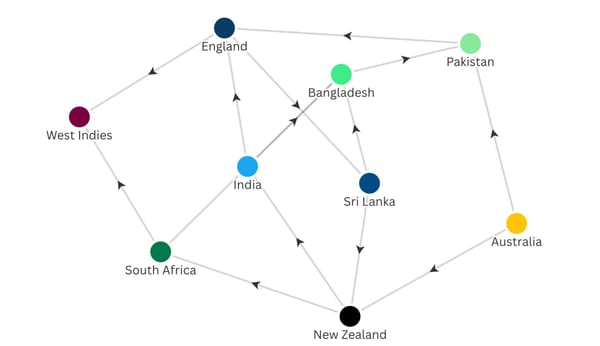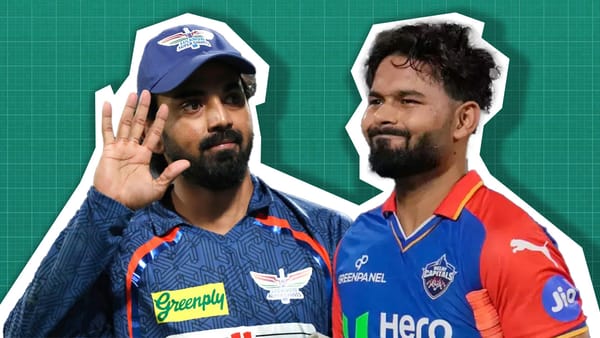Australia lose to ghosts of former pitches
We go deep into the weeds here.
Alex Carey sweeps
You might be thinking, why on earth are you starting with talking about Alex Carey sweeping? How can that be the biggest issue? The man played some sweeps, let him live. But what he also did was play them 66% of all his shots against spin.

That has gone beyond a western player getting to Asia and just trying something, it’s now a creepy obsession. If sweeps were a person, Carey would be looking through their windows at night hoping for a little bit of nudity. And while he tried a bunch of sweeps, it was the reverse that he really obsessed over.
Basically, the most dangerous and pre-meditated shot was the one he hitched his innings to. And you’re not going to be shocked he was dismissed by them in both innings.
Look, sweeping is fine, I sweep, some of my best friends are sweepers, I’m pro-sweep, captain of the sweep club over here. But this wasn’t sweeping, this was a theory that ate his brain. You can’t play more premeditated shots than defensive ones and last a long time. It shows where Australia’s head was.
Alex Carey was batting like his arse was on fire even before Australia had been bowled out once.
Runs per over in India's innings
It all started so early. India took two wickets with the new ball to start the game, Cummins took one with the second new ball and Shami also set had Marnus LBW and then Ashwin started taking wickets. The only time a new ball was wasted was by one of the greatest fast bowlers in history.

He bowled good spells later on, it wasn’t that all his bowling was trash. But he was bad really early on after Australia had made no runs. The twin Axar partnerships were more dramatic, but India got off to a flyer because Cummins could not find a length.
Of course, that only happens because Rohit hit a bunch of boundaries. His innings probably looks less impressive now that Mohammad Shami made 40% of the runs Australia managed in the second innings.
Nagpur first-class matches
But the wicket was tricky early on, no one else before Jadeja looked comfortable. And when Rohit was out, the game was still very much in the balance, but if he fails, where would India have been? It was a magnificent effort, and it started right up against Cummins, where he could have blocked him out, and instead, he took him down.
But after Rohit, or even towards the end of his innings, the pitch was easier. We had the data about what the wicket might do, be tough in the first innings, then get better in the middle, before falling away quickly at the end. If Australia bowled better when Jadeja and Axar came together and closed out that innings for another 50 runs, then Australia would have been batting during the evening of day two and early on day three.

That doesn’t mean they wouldn’t have been ripped out anyway, but the wicket was at its slowest and most benign, and India got almost all of this.
Now, some of this is the bowlers and scoreboard pressure as well. So while Australia didn’t make 100, this was not a 100AO kind of wicket even when they batted. But if Australia got through the Indian lower order in a session, the entire game would be different.
There are two key takeaways from the Australian spinners, one is that they did look tired by the time Jadeja and Axar came out. Boland and Cummins did not bowl a lot, Marnus’ overs were not ideal and there was no true fifth bowler.
Cameron Green’s injury plays a part here. But they also could have picked Ashton Agar at seven, a risky move, but looking at the rest of their batters, it might have been fine. And Agar’s overs could have rested the specialist spinners more.
Axar v off-spin
The second bit is that Australian spinners generally get over spin, and even though they adapted well to the conditions by bowling quicker and using more Asian methods like coming around the wicket. And India were 240/7, if Lyon had taken more wickets, Australia would have been in the match.
But they bowl with more topspin, and this was not a wicket where the bounce played a part. It was all about the side spin, as Ashwin and Jadeja certainly showed they have that. We even know looking through Axar’s record against off-spin what works better in India.

He has struggled against off-spin so far in Tests, but that is against spine spinners, the guys he has faced the most are the Australian type who get more over spin. Even Will Somerville, who plays for New Zealand but is more of an Aussie-style off-spinner.

When you look at the best spinners in the world since the start of their careers, there is an obvious difference between the quality of the bowlers.

But also while Nathan Lyon is a very good spinner in a variety of conditions, he doesn’t step up in Asia like other spinners. It probably goes back to him being a slower bowler and that over-spin we talked about. But where spin is King, Lyon is blah. Only in Bangladesh has he ever dominated.
If you look at the best spinners when they come to Asia, he is not at the pretty end. He is right up the wrong part. Ashwin and Jadeja are pretty handy here. Lyon’s main reputation comes from taking wickets everywhere else. There is a clear talent gap here.

Peter Handscomb v Spin
That reminds us of Peter Handscomb. India were picking between Shubman Gill and Suryakumar Yadav, and Australia picked Handscomb because he is right-handed. A man who after 2016 really hasn’t made many first-class runs.
He hung around for a little while in the first innings, but it feels like a huge effort for Handscomb - or Renshaw - to be thrown back into Tests against the best team in the world at home.
David Warner
So if that is what is happening down the order, then what you really need is one of your best players to really step up. Yet David Warner did not. At this stage, we know that he struggles away from home, in Asia, in India and versus Ashwin.
That does seem to be a lot to go up against, is averaging 30 a win for him this series? And if that is the case, and he is your third-best batter, what on earth is your best-case scenario in this series?
This brings us all to Travis Head, who in the last few days has become the greatest player in Australian history. In this game, Head could have easily played over Renshaw, but there was no plan he was going to start. Green’s injury probably made it more necessary.
However, we know Head struggles against spin and in Asia. I have no problem with them not playing him when Green was playing, and really not that much of an issue with Renshaw playing before him. But if you do drop a guy on form and your team barely makes 250 runs in the match, people are going to suggest the man you dropped was the mistake.
It is worth pointing out that Australia were without Starc and Hazlewood, but I am not sure both could play anyway, and India is missing Bumrah and Pant. Green is probably the most important player missing for either team, but who knows what he will do? He is far from a banker at this stage in his career.
But at least he was a right-hander.
Lefties in this test
There is the entire left-handlers thing. In this game, the Australian left handlers averaged less than zero, and the Indian ones averaged slightly more than that.
Sure there is a big difference between a left-hander dropped into Asia and someone brought up here. But even so, this is an issue.
Jadeja and Axar’s partnership was the most important of the game, and the fact that it was two lefties was just trolling Australia.
Partnerships
And that brings us back to partnerships as a general construct. Australia basically didn’t have more than one and a half, India had more than that from their tail. But Australia just lost bunches of wickets while India never had two fall really quickly.

That is probably because Australia seemed to bat completely differently after each wicket, while India batted as if they understood how to bat.
The pitch
Interesting treatment of the pitch in Nagpur. The groundstaff watered the entire centre of the surface & only the length areas outside the left-hander’s leg stump & then rolled only the centre, stopping short every time they got to the good length areas at both ends #IndvAus
— Bharat Sundaresan (@beastieboy07) 12:11 PM ∙ Feb 7, 2023
There is also another important thing here. I know a lot of people want to blame Bharat, and that is fun, and I will do that in the next episode of Uncovered.
But Australians didn’t get freaked out with the pitch because Bharat took a photo, they have been getting freaked out by India since the 1960s. they were pre-freaked. Outside the whole left-handlers in India thing, Australia doesn’t trust the surfaces, doesn’t handle the conditions well, and doesn’t enjoy these tours.
You can add in the entire doctored arguments - although this wicket played pretty similar to normal first-class Nagpur wickets. But they are looking for evidence it is unfair. If Bharat’s photos do prove to doctoring, it still played no part in this match. Because the photos show they were setting it up for left-arm spinners to use the rough against the lefties. We never got far enough in the match for that to be an issue, and Ashwin got most of them off the good part of the wicket.
Australia didn’t lose because of the doctored pitch, but as is almost always the case, they lost because of a fear that it was.
A quick history lesson, they also thought the Pune wicket last time they toured was doctored. But Smith just kept batting, Steve O’Keefe played beautifully, and they got the win.
They then thought the Bangalore and Ranchi wickets were doctored. They lost a great Test in the first and then drew the second on a feather bed. They complained all three wickets were doctored, despite winning one, drawing another and having a slight chance in the third.
And then they got the one surface that could help them in the last match, and India won.
And this is where the real truth of why Australia struggle in India, even during the glory years. they are not just playing India, but their own fears and insecurities about India. They have been programmed over a lifetime to not trust the pitches, and so they aren’t just fighting R Ashwin and Rohit Sharma, but all the ghosts of the Border-Gavaskar Trophy in the past.
And how does that all come out, Well Alex Carey played more sweeps than is humanly possible and Australia don’t cross 300 runs in the game.




